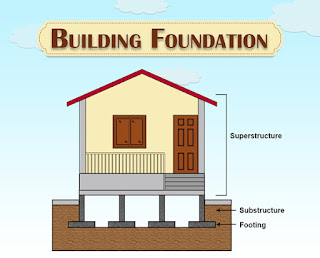IMPORTANCE OF BUILDING FOUNDATION AND IT’S TYPES
A. WHAT IS A BUILDING FOUNDATION ?
Building foundation, footing or substructure, is the most important structure designed to support a building in real estate.
It connects the building to the ground by transferring the load from the building to the ground.
The type of the foundation to be used in constructing a building largely depends on
I. The type or weight of the building and
II. The type or quality of soil present on the estate or land.
Although, the effectiveness of a building foundation may be reduced by different factors such as adverse weather or climatic conditions.
It is advisable that the right foundation must be used for a building to prevent dilapidation or building collapse.
B. WHAT ARE THE DIFFERENCES BETWEEN BUILDING CONSTRUCTION WORKERS IN NIGERIA
Differences between Architects, Geotechnical Engineers, Structural Engineers and Quantity surveyors in Nigeria.
Architects are licensed professionals trained in the art and science of building designs. They plan, design, oversee and develop the concepts for construction of buildings.
Geotechnical engineers are specialized civil engineers who investigates, research and study soils to evaluate it’s suitability for building construction.
Structural engineers are primarily concerned with analyzing, designing, planning, research and constructing building structures .
They ensure buildings are safe and capable of withstanding the elements to which they will be exposed.
Quantity Surveyors are construction professionals with expert knowledge in calculating the cost of materials needed to complete a building project.
C. FACTORS THAT DETERMINE THE TYPE OF A BUILDING FOUNDATION
a. Geological engineering and hydrogelogical conditions at the construction site
b. Purpose and design of the building or structure.
c. Magnitude of the load imposed on the foundation
d. Production capacities of the construction organization.
D. TYPES OF BUILDING FOUNDATIONS
1.) Shallow foundation
2.) Deep foundation
1.) SHALLOW FOUNDATIONS
Shallow foundation transfers building loads to the surface, rather than to a subsurface layer or a range of depths.
They are usually embedded about a metre or more into the soil.
Shallow foundations are common in excavations or trenches which are usually found in residential homes and commercial or industrial buildings.
The dimensions of a footing are determined in a way the average pressure on the bedding does not exceed a design value.
That depends on the nature and properties of the earth, the depth of the foundation and the design features of the structure.
TYPES OF SHALLOW FOUNDATIONS
I. Individual/Isolated footing/pad foundation.
II. Combined foundation
III. Spread/Strip foundation
IV. Raft/Mat foundation
I. INDIVIDUAL/ISOLATED FOUNDATIONS
Individual or Isolated foundations are the most simple and common of all types of building foundations for real estate Properties and building construction in Nigeria and the world at large.
In addition, they are used when the load of the building is carried by columns, usually constructed for single columns.
Also note that, Shape of individual footing foundation is square or rectangular or circular and is used when loads from the structure is carried by the columns.
The Size of the individual footings is calculated based on the load on the column and the safe bearing capacity of soil.
There are different types of isolated foundations, some of which includes;
Single pad footings, Stepped footing for a column, Sloped footing for a column, Wall footing without step, Stepped footing for walls, Grillage foundation e.t.c
II. COMBINED FOUNDATIONS
Combined footings or foundations are constructed when two or more columns in the building are in close contact to each other and their foundations overlap.
According to it’s name, combined foundation is a combination of isolated footings, but differs only in the structural design.
The shape of combined footing foundation is rectangular, trapezoidal and T-shaped.
III. SPREAD/STRIP/WALL FOUNDATIONS
Strip foundations are closely positioned shallow foundations used to provide a continuous, stepped strip of support to a linear structure such as walls, bridge piers or closely-spaced rows of columns built centrally above them.
This is because their base is wider than a typical load-bearing wall foundations.
The wider base of this footing type spreads the weight from the building structure over more area and provides better stability.
Strip foundation helps provide better stability for the building by spreading the weight of the building over a wider area.
There are three types of strip foundations which includes – traditional shallow strip, wide strip and deep strip or trenchfill foundations
IV. RAFT/MAT FOUNDATIONS
Raft or mat foundations are the types of foundation which are spread across the entire area of the building in order to support heavy structural loads from columns and walls.
Raft foundations prevents differential settlement and are more suitable for expansive soil types whose bearing capacity is less suitable for individual footings or combined footings,
Most importantly, it effectively carries the weight of the building much better since the foundation is spread over the entire area of the building.
They are used on soft compressible subsoil such as soft clay or peat as they cover an area at least the same sizes as the base of the building.
Raft or mat building foundations should not be used where the groundwater table is above the bearing surface of the soil due to scour and liquefaction.
There are five main types of raft foundatio which are Solid slab rafts, Slab beam rafts, Cellular rafts, Piled raft foundations and Balancing (or floating) rafts.
2.) DEEP FOUNDATIONS
A deep foundation is a type of foundation that transfers loads of a building structure to greater depths below ground level from the surface.
Deep foundations are laid with drill-filling and driven piles(pile foundation) deep piers(driven or made of casings) and caissons.
They are used mostly found in water logged or high ground water level locations used in the construction of bridges and deep underground structures due to their weak, subsiding or weak nature.
TYPES OF DEEP FOUNDATIONS
I. Pile foundations.
II. Drilled Shafts or Caisson foundations
III. Pier or Cylinder foundations
I. PILE FOUNDATIONS
Pile foundation is a type of deep foundation which is used to transfer heavy loads from the structure through columns to a hard rock or soil strata which is much deeper below the ground level where shallow foundations cannot be used.
They are used to support buildings in subsoil conditions where soil conditions near the ground surface is not suitable for heavy loads such as shrinkable clays, infill or waste tips, slopes and sites with a high water table in a poorly drained region.
Pile Foundations are also used to prevent uplift of the structure due to lateral loads such as earthquake and wind forces.
They also serve as substitutes where conventional foundations would need to be so deep that they would be uneconomical.
Pile foundations are used when there is a layer of weak soil at the surface or a building has very heavy, concentrated loads, such as in a high rise structure.
The types of pile foundations are classified based on ;
I. Function or Use ( Sheet Piles, Load Bearing Piles, End Bearing Piles, Friction Piles, Soil Compactor Piles ) and
II. Materials and Construction Method ( Timber Piles, Concrete Piles, Steel Piles, Composite Piles)
II. DRILLED SHAFTS OR CAISSON FOUNDATIONS
Drilled shafts or caissons foundation is a type of deep foundation helps resists loads from structure through shaft resistance, toe resistance and/or combination of both of these.
The construction of drilled shafts or caissons are done using an auger.
Though, Drilled shafts and Pile foundations are similar in operation, they are called high capacity cast-in-situ foundations because they are used to transfer column loads larger than pile foundations to depth of hard strata below ground level within 25 feet to 300 feet.
Drilled shafts or caisson foundation is not suitable when deep deposits of soft clays and loose, water-bearing granular soils exist. It is also not suitable for soils where caving formations are difficult to stabilize, soils made up of boulders, artesian aquifer exists.
These are the types of caisson foundations we have – Box Caissons, Floating Caissons, Pneumatic Caissons, Open Caissons, Sheeted Caissons and Excavated Caissons.
III. PIER OR CYLINDER FOUNDATIONS
It consists of an underground cylindrical structure (pier) that transmits a heavy load from superstructure to the soil by end bearing. cannot be carried by shallow foundations.
These are generally utilized in multi-story structures because they are shallower than piles and can transfer load by bearing and by not skin friction.
Read more on Basements and Hollow Box Foundations (Buoyancy Rafts)
E. IMPORTANCE OF STRONG FOUNDATIONS IN BUILDING CONSTRUCTION
1.) Foundation distributes uneven loads of the superstructure to a large area of soil uniformly so
as the intensity of the load at its base does not exceed the safe bearing capacity of the subsoil.
2.) Strong Foundations supports the building structures from being tilted or collapsing.
3.) It provides safety to the structure against undermining or scouring due to animals, flood water, etc.
4.) Leveled and hard surface to the superstructure, over which superstructure can be built.
5.) Foundations keeps the interior structure of the building free from dust, rain water, flood etc
6.) They serve as major role for improving aesthetic look of buildings.
7.) They help hold the structure firmly against natural forces including earthquakes, floods, frost heaves, tornadoes and wind.
8.) It enhances lateral movements of the supported structure.
9.) Anchors the structure deeply into the ground, increasing its stability and preventing overloading.
Post Script
Contact us for bungalow, Land for sale, penthouse, home for sale, lagos cheap houses, houses for sale in nigeria, bed room house for sale in lagos, duplex, terrace, real estate broker,Container home,Luxury homes, Smart homes, Property valuations, real estate business plan, poperty development, home for sale, real estate business plan, online real estate agency, land agent, real estate legal services, title company, estate liquidator, estate planning lawyer, estate planning, setting up estate company, serviced apartment, apartment sales and lettings, apartment building, bedroom flat, Selfcontain, single room for rent, real estate investment options, real estate investment trust, realestate investment group, real estate investment firms, real estate investment loans, real estate investment clubs, real estate attorney, realtor, real estate marketing materials/tools/ideas/plans, real estate marketing flyers, PWAN marketing flyers, rent to own realtors, real estate leads for realtors, realtor course, Land banking, property lawyer, property auctions, property management software, house plans, house insurance, and students' accommodation.
SMS, Call or WhatsApp: 07030765952
bikejoseph@gmail.com
https://joenigeria.blogspot.com
For updated land listings nationwide
More information About Joe Nigeria











Comments
Post a Comment